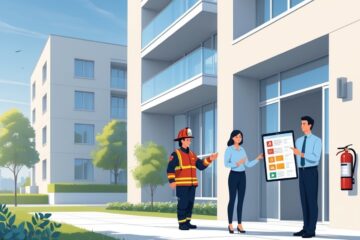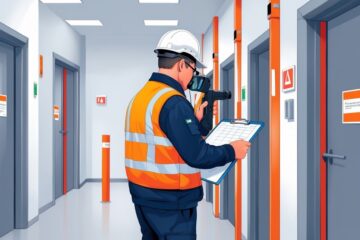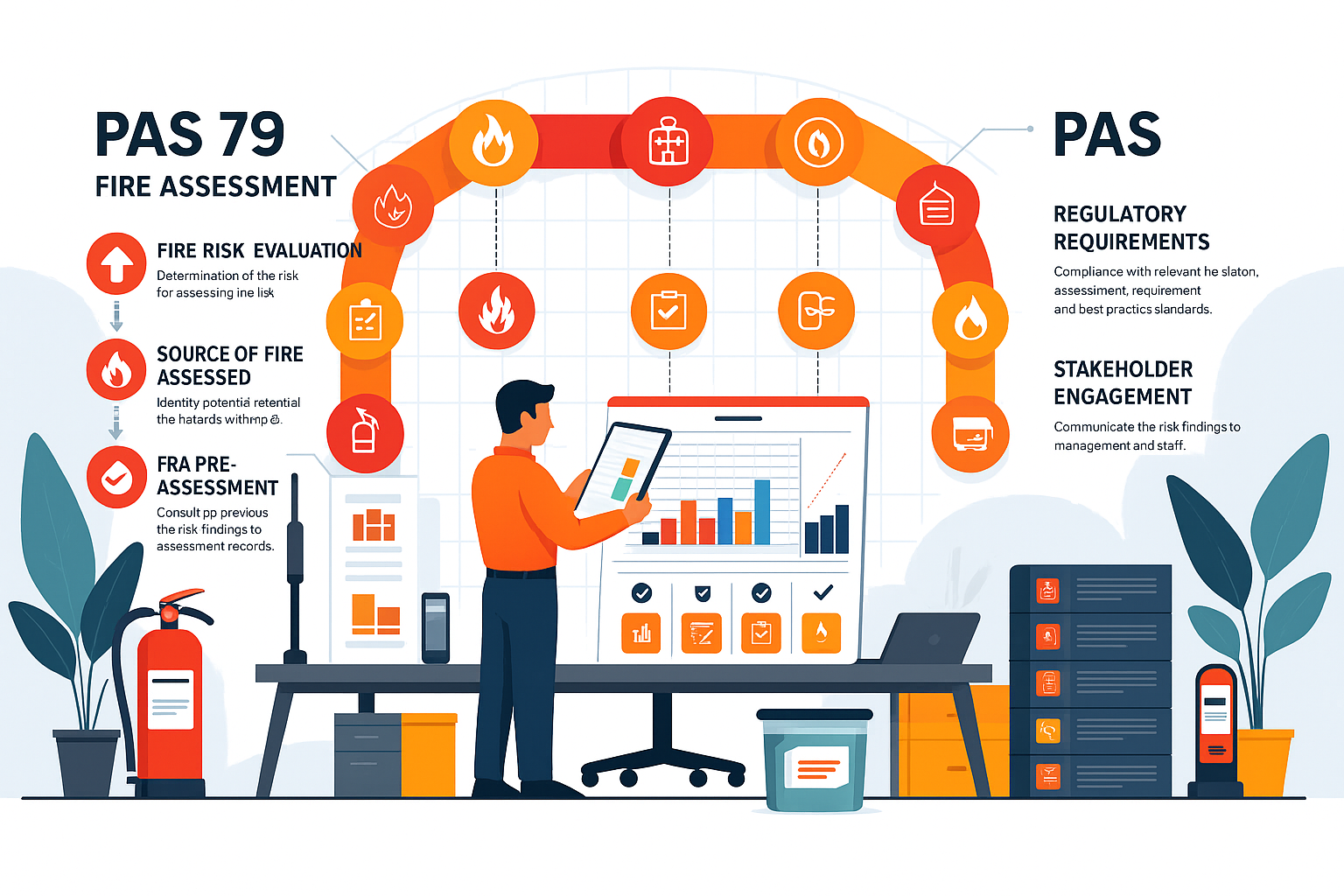Last winter, Sam, the estates officer for a mixed-use block in Bromley, got a 2 a.m. call. A tenant had burnt toast, the alarm blared, and nobody could silence the panel because the last service sheet was missing. Sam realised that even though the weekly test box was ticked, the six-monthly check was months late. He isn’t alone—many managers juggle dates, reports, and tight budgets. Let’s clear the fog.
1. BS 5839 Basics — the rulebook in plain words
Understanding the significance of BS 5839 Fire Alarm Inspections is crucial for maintaining safety standards.
Regular BS 5839 Fire Alarm Inspections help ensure compliance with safety regulations and is a part of general Fire Safety regulations.
BS 5839-1 is the British Standard that tells us how to design, install, and look after fire-alarm systems in non-domestic buildings. Think of it as a recipe: follow it and the system will work when you need it most.
Each of these reasons highlights the importance of BS 5839 Fire Alarm Inspections for property managers.
Why care?
- It’s proof you’ve done your duty under the Fire Safety Order.
- Insurers want to see up-to-date certificates.
- It keeps tenants, shoppers, and staff safe.
Key points you’ll hear about:
- Weekly user test — press one call-point every week.
- Six-monthly service — a competent engineer checks half the devices.
- Annual service — every device gets a turn.
- 65 dB(A) rule — alarms must reach at least 65 decibels in occupied areas (75 dB at the pillow if people sleep)
Conducting BS 5839 Fire Alarm Inspections can save lives and protect property.
Put simply: weekly pokes, two professional visits a year, and loud enough bells.
2. Six-Monthly vs Annual — what really happens on each visit?
You might hear folk argue that one big yearly overhaul is “enough.” BS 5839 doesn’t agree. Here’s a bite-sized rundown:
| Check Point | Six-Monthly Visit | Annual Visit |
|---|---|---|
| Visual look-over of panel & log book | ✅ | ✅ |
| Sounders, bells, strobes | 50 % | 100 % |
| Call-points | 50 % | 100 % |
| Backup batteries & power | ✅ | ✅ |
| Sound level spot checks | ✅ | ✅ |
| Clean devices if dusty | ✅ | ✅ |
| Issue inspection certificate | ✅ | ✅ |
Why split the workload? If a device fails six weeks after a one-off yearly test, you could have eleven months of silent trouble. The six-monthly rhythm halves that risk. BS 5839-1:2017 makes this clear
Tip: Keep a wall-calendar or cloud reminder that shows both service windows; many managers in Croydon set March and September so they never clash with year-end budgets or Christmas shutdowns.
In addition, BS 5839 Fire Alarm Inspections ensure that alarms function correctly when needed.
3. dB Test Demo — hearing is believing
Sound-pressure tests can feel scary, but they’re simpler than a school fire drill. Follow along with this small demo, you can watch on site:
Therefore, regular BS 5839 Fire Alarm Inspections are not just beneficial but necessary.
Grab a meter
A cheap Class 2 dB meter costs £25 online. Some engineers use a calibrated one for legal records, but a quick pre-visit check with any meter helps you spot dodgy sounders. Remember, regular BS 5839 Fire Alarm Inspections will help catch any potential issues before they escalate.
Pick a busy spot
Stand in the café kitchen or open-plan office. Shut the doors like it’s a regular workday.
Trigger a sounder
Press the nearest red break-glass. Start the meter at arm’s length.
Aim: 65 dB or more (about a loud vacuum cleaner). For sleeping risk—flats above shops in Lewisham, for example—look for 75 dB on the pillow.
Log the reading
Write it in the fire-log book. If it’s below target, note the room and tell the engineer. Sometimes a door closer, false ceiling, or even a new coffee machine has muffled the noise. Don’t forget the importance of BS 5839 Fire Alarm Inspections when you notice discrepancies.
Repeat in a far corner
Walk to the end restroom or plant room and test again. Different layouts echo differently.
Why bother? Your tenants won’t stand in the corridor when fire starts. They’ll be in meeting rooms or kitchens. Do the dB test where real life happens.
4. Sample Report Screenshots — what good paperwork looks like
Most insurers (and the local London Fire Brigade) will ask for proof. Below are real-world examples of what you should receive after each visit:
- System inspection certificate – shows site address, date, engineer name, scope, and any variations from BS 5839.
- Device test list – tick-box sheet of every sounder, detector, and call-point, with pass/fail notes.
- Fault summary – clear list of issues, prioritised by urgency.
- Sound-level log – readings for each test point.
Scan or file these as PDFs—cloud storage means you never lose them in a desk drawer when auditors appear.
5. Cost & Scheduling Tips — how to keep the budget happy
Let’s talk money. Nobody loves bills, but a well-planned schedule saves grief later.
Make sure to request a detailed report after BS 5839 Fire Alarm Inspections for future reference.
Documentation from BS 5839 Fire Alarm Inspections can also aid in insurance claims.
How much does a service cost?
| Building Size | Typical Price (ex. VAT) | Notes |
|---|---|---|
| Up to an 8-zone panel | £70–£90 | Good for small cafés or single flats |
| Up to 8-zone panel | £130–£200 | Most offices & retail units |
| Large multi-zone or addressable | £200–£400+ | Shopping centres or schools |
Prices in Beckenham and Greenwich sit near the lower end; central boroughs like Westminster trend higher due to parking and congestion charges.
Hidden costs to watch
- Out-of-hours call-outs – choose testing slots at 7 a.m. or 6 p.m. to dodge tenant disruption but still avoid pricey midnight fees.
- Panel faults found on site – allow a small “contingency pot” for surprise battery changes.
- Access equipment – if your sounders sit above 3 metres, you may pay extra for a small scaffold or MEWP hire. (In Camden, a cherry-picker permit on busy roads can add £120.)
Seasonal smart moves
- Spring — schedule big tests before pollen season; detectors hate dust.
- Summer holidays — schools are empty; great time for loud testing.
- Autumn — combine alarm service with emergency-lighting checks before darker evenings.
- December — avoid the last two weeks; engineers, like everyone, juggle parties and reduced staff.
Common Problems We Hear Every Week
- “I never get the paperwork.” — Ask the engineer to email PDFs before they leave site.
- “Tenants silence the sounders.” — Use tamper-proof call-point covers; they cut false alarms.
- “The log book is lost.” — Keep a digital copy in Google Drive; print a fresh sheet for the panel cupboard.
- “We’re refitting the lobby.” — If builders move walls in Hackney, call your fire company; you might need extra sounders.
Wrapping it all up
Staying on top of BS 5839 isn’t fancy—it’s just smart. The Standard sets out three simple beats: weekly user tests, six-monthly engineer visits, and a full annual sweep. Stick to that rhythm and your alarms will shout loud enough (65 dB in offices, 75 dB where people sleep) when it really matters.
We walked through a quick dB meter demo you can copy in any corridor, the kind of screenshots you should see on a decent inspection report, and the price bands most London-area managers are paying right now. You also saw how splitting service dates—say March and September—catches faults sooner and avoids December chaos. And don’t forget the paperwork: log books in the cloud, certificates in your inbox the same day, ready for insurers or the local fire officer.
Bottom line? A clear schedule, a trusted engineer, and a small “surprise battery” fund keep you legal and, more importantly, keep everyone safe without blowing the budget.
Ready to book?
Ready for the bigger picture? Check out the Complete Fire Assessment Guide and drop us a line for a no-pressure quote.
All Well Property Services covers City of London Greater London, Kent, and Surrey. Our engineers:
- Hold BAFE & FIA competence cards
- Carry calibrated dB meters
- Same-day email certificates
- Offer fixed six-monthly reminders
Book your BS 5839 inspection now
Contact us today for your next BS 5839 Fire Alarm Inspections appointment 020 3920 9617.
Let’s keep every alarm loud, legal, and ready.
FAQs
How long is a visit?
Example:
Small shop: 30 min
Large school: up to 3 hours
Do I need to shut the building?
No. We test zones in turn, so staff can keep working.
Can you tie this in with emergency-light testing?
Sure. There can often be savings made when you tie two separate visits.
What if we fail?
You’ll get a clear action list and quote. Fixes can often be done on the same day.


